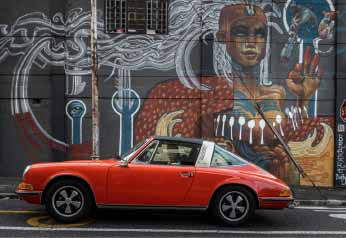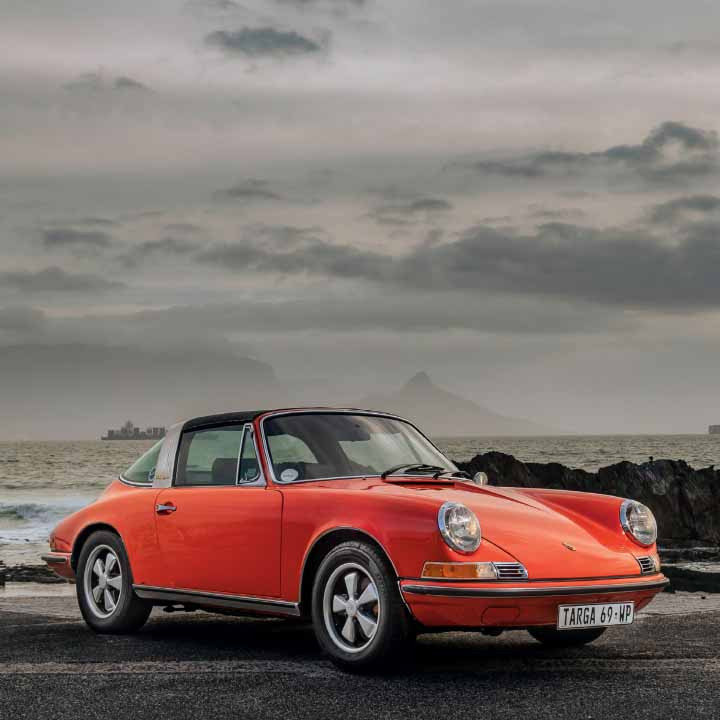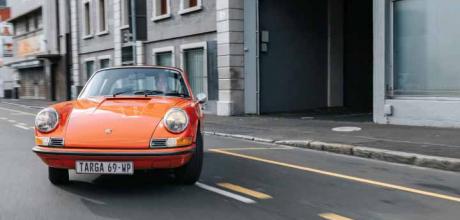1969 Porsche 911 2.0E Targa
Chasing the sunset. Few classic cars are better equipped for a sunset drive along South Africa's west coast than a Porsche Targa. Total 911 rides out of Cape Town for an eveningwith a 1969 E.
There are few more enticing prospects than leaving the city in one of your favourite cars, getting away from the traffic and then heading to the countryside for a beautiful sunset drive. After a few blistering hot days during Cape Town’s summer, I thought we’d have the same type of weather during our planned afternoon drive. However, in the morning there was a short rain spell, clearing the air with some clouds hanging around into the afternoon. It cooled the landscape and cleaned the air, resulting in the perfect refreshing atmosphere for our outing. The owner of this beautiful Tangerine orange 1969 911 2.0E Targa had the car fully restored a couple of years ago. She drove the car all the way down from Johannesburg to Cape Town in December 2020. It was a perfect road trip to celebrate the two years of restoration, as the journey was around 1,000 miles over the course of three days. Today, we wait until most of the traffic has cleared from Cape Town’s road network and then leave the city. Because it’s already 6pm (the sun only sets around 8pm) most of the inner-city traffic has dispersed, so we make our way along the R27 that hugs the coast and heads through mostly residential areas. Between the mundane and regular city traffic, the Targa stands out.

This is thanks in no small part to its compact footprint compared to today’s significantly larger vehicles, and its beautiful orange colour. We decided to keep the roof on for the first part of the journey. I’m quite surprised by the lack of creaks and rattles. This is, after all, a 53-year old car, but even from the Targa top there aren’t any significant noises. It’s at times like these that you could mistake your driving experience with that of a Coupe of the same year. The Targa is comfortable to potter around in. Although the gearbox takes a few shifts to learn, it soon becomes easy to navigate your way through the dogleg gearbox. My view from the driver’s seat is excellent and I have a near-perfect idea and view of the car’s extremities. We stop at Bloubergstrand Beach, offering one of the best-known sights and sounds of Cape Town – the typical postcard that you’d sent back home in the previous century or Instagram-bound photograph that you’d take today.
Come here on St Valentine’s evening and the beach is packed, thanks to the perfect view over the bay to Cape Town and thecity’s most visible landmark: Table Mountain. Today the misty clouds are covering the mountain, but we can still clearly see its outlines. The Targa’s exterior colour offers a strong contrast to the grey sky and blue water, and a number of joggers turn their heads to take a second look. I pull the lever below the ‘B’ pillar to open the engine lid. These early 911 models’ engine bays are so spacious – you can clearly see all the exterior parts of the engine. Having only around 2,600 miles on the odometer since its full restoration, it looks brand new, replete with all its stickers at the bottom. The 911E replaced the 911L in 1969. With a new dual-row injection pump, the E now offered 10bhp more, for a total of 140bhp. A brand-new Targa retailed for DM26,470 in Germany, which was a DM1,780 premium over the Coupe. Before we leave we decide to take the roof off and enjoy some al fresco motoring – this is what the car was designed for, after all. This can be done by a single person, but having two pairs of hands makes it quicker and easier. Simply turn the two levers on the inside of the cabin that are situated above the windscreen, and then lift the roof up.

You then press the outer frames towards each other and it folds up like a concertina. We open the front lid and carefully place it on the compartment floor before closing the lid again. Immediately it’s as if the matte (brushed) metal Targa hoop becomes more of a feature than when the Targa top was in place. As we pull away, the rhythmic beating of the flat six engine is more audible and the smell of the ocean stays as we drive on. We make our way through Bloubergstrand and head along a short stretch of the M19 towards the N7. There are some eucalyptus trees along the way before the vast expanse of farms in the countryside become visible. A short stint on the N7 takes us north. It’s here where the Targa shows another of its useable features. It easily keeps up with modern traffic with the rev counter sitting just below 4,000rpm at an indicated 75mph. Put your foot down and the speed simply continues to increase, allowing ample performance for overtaking traffic. Impressive performance for a 2.0-litre engine!
I’m also impressed by how little wind buffeting there is in the cabin – especially considering I have the driver’s side window open and I’m over six feet tall. The cabin is marginally noisy, but with slightlyraised voices I can even keep a conversation going with Peet Mocke, the photographer who’s joined me on my evening expedition. We fill up with petrol at the fuel station and make our way down the road to the village of Philadelphia. The white NGK church that dates from 1863 is one of the local landmarks, along with a number of other quirky shops and the Pepper Tree restaurant. All of them are closed for the day, but we can’t help but look to the skies and appreciate the corresponding orange it’s turning into with a dash of pink. As we leave this small countryside town I press the throttle a little bit deeper. This will be my last chance to enjoy a few corners before we join the highway leading back towards Cape Town. The lightweight and compact nature of the 911 presents itself immediately, especially through the turns. You can’t rush the five-speed gearbox, but then you also don’t want to because you can spend more time appreciating the steering feedback, the balanced suspension and the willing engine.

Even from 3,000rpm the engine is eager to rev; and past 4,000rpm even more so. This leaves ample room for more performance on offer – the redline only arrives just before 7,000rpm. The relatively small steering wheel brims with feedback. There’s no power steering, but because the car is so light and most weight is on the rear axle, it takes very little effort through the steering wheel to point the car in your desired direction. That was even the case at parking speeds. It’s at times like these that the 911 shrinks around you. With the roof off, you also have all your sensations elevated, be it the setting sun visible on the horizon or the mechanical sound from the little 2.0-litre flat six engine. Apply the brakes and the E easily scrubs off speed, giving you even more confidence to drive the car in the way it was intended.
1969 also signalled the start of the 911’s B-Series production, when these car’s wheelbase was increased by 57mm, marginally improving on-thelimit handling. Back on the highway with the roof down, the cooler environment makes a perfect drive back to the city. These roads are in near-spotless condition, and the combination of the relatively plump 195/65 R15 tyres on beautiful 15-inch Fuchs contributes to the comfortable ride. The seats are another highlight. If you spend hours in seats and you never think about them, then they’re doing a fine job. In this Targa you never doubt you’re driving a sports car, but the level of comfort is welcoming – especially if you’ve spent a long time in the seat. The view over the orange bonnet ties in perfectly as the sun sets in the west and the day comes to an end. I used to frown a little when someone said they’ve bought a Targa, but now I understand it a little better. It does offer the best of both worlds


